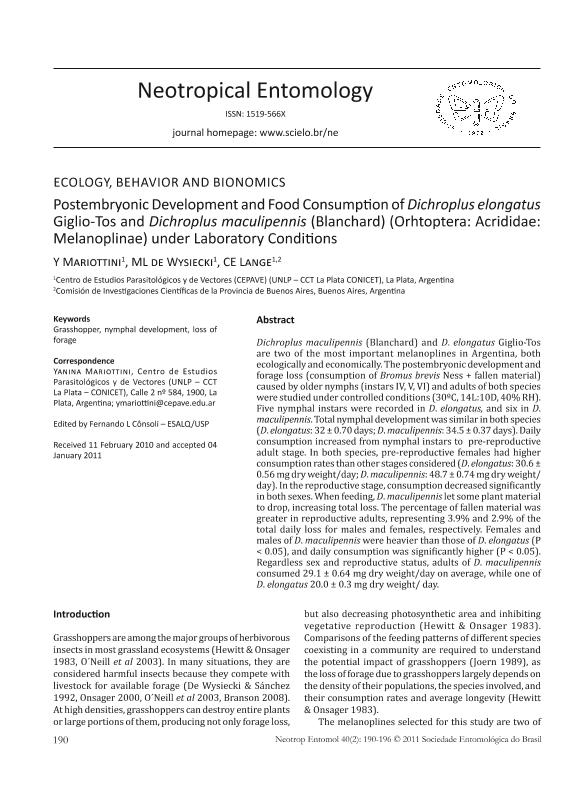Artículo
Postembryonic development and consumption of the melanoplines Dichroplus elongatus Giglio-Tos and Dichroplus maculipennis (Blanchard) (Orhtoptera: Acrididae: Melanoplinae) under laboratory conditions
Fecha de publicación:
03/2011
Editorial:
Sociedade Entomológica do Brasil
Revista:
Neotropical Entomology
ISSN:
1519-566X
e-ISSN:
1678-8052
Idioma:
Inglés
Tipo de recurso:
Artículo publicado
Clasificación temática:
Resumen
Dichroplus maculipennis (Blanchard) and D. elongatus Giglio-Tos are two of the most important melanoplines in Argentina, both ecologically and economically. The postembryonic development and forage loss (consumption of Bromus brevis Ness + fallen material) caused by older nymphs (instars IV, V, VI) and adults of both species were studied under controlled conditions (30°C, 14L:10D, 40% RH). Five nymphal instars were recorded in D. elongatus, and six in D. maculipennis. Total nymphal development was similar in both species (D. elongatus: 32 ± 0.70 days; D. maculipennis: 34.5 ± 0.37 days). Daily consumption increased from nymphal instars to pre-reproductive adult stage. In both species, pre-reproductive females had higher consumption rates than other stages considered (D. elongatus: 30.6 ± 0.56 mg dry weight/day; D. maculipennis: 48.7 ± 0.74 mg dry weight/ day). In the reproductive stage, consumption decreased significantly in both sexes. When feeding, D. maculipennis let some plant material to drop, increasing total loss. The percentage of fallen material was greater in reproductive adults, representing 3.9% and 2.9% of the total daily loss for males and females, respectively. Females and males of D. maculipennis were heavier than those of D. elongatus (P <0.05), and daily consumption was significantly higher (P<0.05). Regardless sex and reproductive status, adults of D. maculipennis consumed 29.1 ± 0.64 mg dry weight/day on average, while one of D. elongatus 20.0 ± 0.3 mg dry weight/ day.
Palabras clave:
Grasshopper
,
Loss of Forage
,
Nymphal Development
Archivos asociados
Licencia
Identificadores
Colecciones
Articulos(CEPAVE)
Articulos de CENTRO DE EST.PARASITOL.Y DE VECTORES (I)
Articulos de CENTRO DE EST.PARASITOL.Y DE VECTORES (I)
Citación
Mariottini, Yanina; de Wysiecki, Maria Laura; Lange, Carlos Ernesto; Postembryonic development and consumption of the melanoplines Dichroplus elongatus Giglio-Tos and Dichroplus maculipennis (Blanchard) (Orhtoptera: Acrididae: Melanoplinae) under laboratory conditions; Sociedade Entomológica do Brasil; Neotropical Entomology; 40; 2; 3-2011; 190-196
Compartir
Altmétricas




